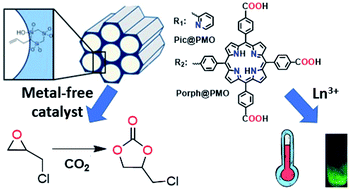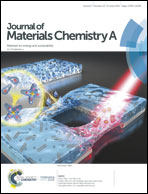Functionalized periodic mesoporous organosilicas: from metal free catalysis to sensing†
Abstract
In this work a widely usable post-modification route for periodic mesoporous organosilicas (PMOs) was developed. Using the developed method, two diverse ligands, picolinic acid (Pic) and 4,4′,4′′,4′′′-porphyrin-5,10,15,20-tetrayltetrabenzoic acid (Porph), were successfully covalently coupled onto the PMO material and well-characterized. Both obtained materials show high BET surface areas (565 m2 g−1 for Pic@PMO, 483 m2 g−1 for Porph@PMO and 548 m2 g−1 for the unmodified PMO) and pore sizes (5.1 nm). The materials were subsequently tested for their catalytic activity in the cycloaddition of epoxide and CO2, a frequently studied carbon capture and utilization reaction. Interestingly, both materials showed very good reactivity (with conversions of up to 90%) as metal free heterogeneous catalysts and proved to be perfectly stable in recyclability and aging tests. Moreover, by (co-)grafting Eu3+ and Tb3+ ions onto Pic@PMO and Yb3+ ions onto Porph@PMO a strong emission was observed in the visible and near-infrared (NIR) range, respectively. Eu,Tb@Pic@PMO showed potential for use as a temperature sensor in the physiological range (a maximum Sr value of 2.11 %K−1 was obtained at 273 K), while Yb@Porph@PMO could efficiently be excited within the human tissue penetrating window showing characteristic Yb3+ luminescence (with decay times of around 10 μs). These findings prove that simple modifications of this PMO can provide smart materials for very diverse applications.



 Please wait while we load your content...
Please wait while we load your content...